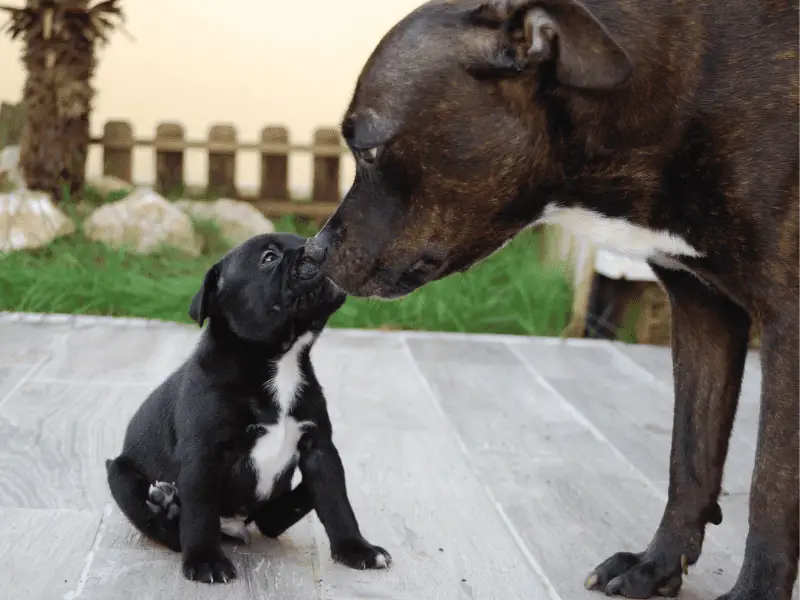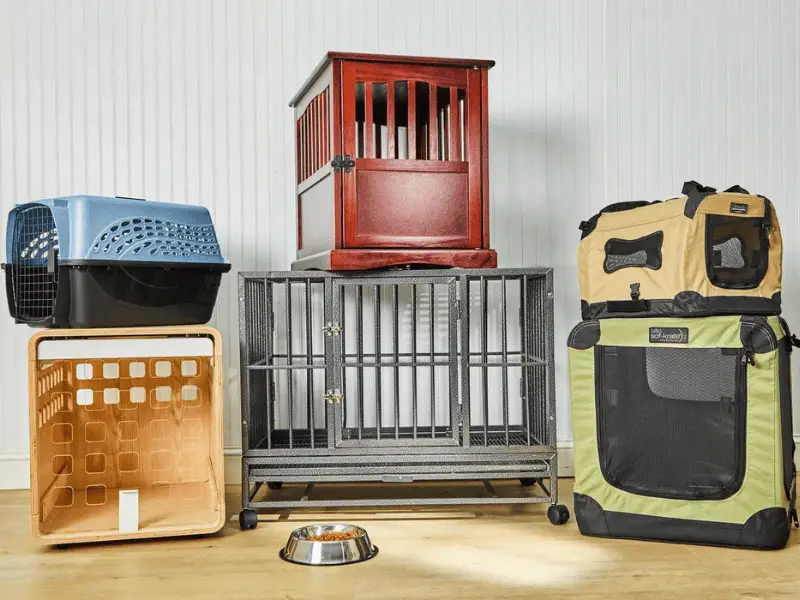Can big and small dogs get along? Let’s look at issues related to big dog and small dog compatibility — how to introduce them, potential challenges, and strategies for maintaining a harmonious relationship.

The Great Dog Debate: Can Big and Small Dogs Truly Coexist?
It’s a question that has plagued many pet owners for years. Can a big dog and small dog really share the same household without chaos erupting?
While there may not be a cookie-cutter answer to this question, the short version is, yes. However, there are several factors that can influence whether or not two dogs of varying sizes will get along.
My Personal Experience with Big and Small Dogs
I’ve always been a major animal lover, and growing up I had both big and small dogs in my family. One of my most memorable experiences was when we brought home our new Golden Retriever puppy while already having an older Chihuahua in the house.
I remember being worried about how they would react to each other since they were such different sizes, but after some careful introductions, they quickly became inseparable.
The two of them would play together for hours on end, with our little Chihuahua often climbing on top of our Golden Retriever like he was a play structure. Despite their large size difference, it was clear that these two pups got along famously.
However, not all dog relationships are as easygoing as my personal experience. In fact, there are several factors that pet owners should consider before bringing home another pup – especially if one is significantly smaller or larger than your current furry friend.
Factors that Affect Dog Compatibility
Dogs come in all different shapes and sizes, with unique personalities and temperaments. When it comes to big and small dogs getting along, there are a number of factors that can affect their compatibility.
Size difference and compatibility
One of the first things to consider when introducing a big dog and a small dog is their size difference.
While size isn’t always the determining factor in compatibility, it’s important to be aware of any potential dangers that may arise from having a large dog around a smaller one.
Large dogs may accidentally hurt smaller ones, especially during playtime or roughhousing. That being said, there are many cases where big dogs are gentle giants and get along well with smaller breeds.
Temperament and personality traits
The temperament and personality traits of each individual dog also play an important role in their compatibility with one another. Some dogs are naturally more laid-back and relaxed, while others may be more energetic or aggressive.
It’s important to assess each dog’s personality before introducing them to one another. For example, if one dog is highly territorial or prone to biting, this could spell trouble for peaceful coexistence with other pets.
Socialization history and experiences
A dog’s socialization history can also have an impact on its ability to get along with other dogs. Dogs who were not exposed to other animals during their critical socialization period (between 3-12 weeks old) may have difficulty interacting with unfamiliar animals later on in life. On the other hand, dogs who have been well-socialized from an early age tend to be more comfortable around new people, places, and pets.
Whether big and small dogs can get along together successfully depends on various factors like size difference between them, temperament/posture, and socialization experiences.
However, with a little bit of patience, positive reinforcement training techniques, and careful supervision during initial interactions, it’s possible for big and small dogs to coexist peacefully in the same household.
Tips for Introducing Big and Small Dogs
Supervision and Control during Initial Interactions
Introducing big and small dogs should always be done under close supervision, especially during the first few interactions. It’s important to have control over the situation to prevent any aggressive behavior that might arise.

One effective way to control the situation is by placing both dogs on a leash during their first meeting.
This will ensure that they are both within your control if anything goes wrong. If either of the dogs exhibits any signs of aggression or discomfort, separate them immediately.
Positive Reinforcement Training Techniques
Using positive reinforcement techniques can help create a positive association between big and small dogs during their initial meetings. One effective technique is to reward both dogs for good behavior with treats, praise, or playtime.
You can also use clicker training, which involves using a clicker sound to indicate when a dog performs good behavior such as approaching each other calmly or sitting quietly.
Gradual Exposure to Each Other’s Scents, Sounds, and Presence
Gradually exposing big and small dogs to each other’s scents before actually meeting face-to-face can help reduce anxiety and nervousness during their first interactions.
Start by exchanging blankets or toys between the two dogs so they can become familiar with each other’s scent. Additionally, playing audio recordings of dog sounds such as barking or growling, can also help get them accustomed to each other’s presence before their first encounter.
It’s important to take things slow when introducing big and small dogs.
By following these tips for introducing them in a controlled environment using positive reinforcement techniques while gradually exposing them to each other’s scents, you increase the chances of creating harmonious relationships between big and small dogs in your household!
Common Challenges in Big-Small Dog Relationships
Dogs of different sizes may face some difficulties when living together. Even though it’s possible for them to get along well, a few challenges can arise. Here are some of the most common ones:
Dominance struggles between the two dogs
One of the biggest challenges with big-small dog relationships is the potential for dominance struggles between the two pets. Larger dogs may try to assert their dominance over smaller ones, which can cause conflict and tension.
This can be especially problematic if both dogs have strong personalities and neither one is willing to back down. To prevent this kind of situation, it’s essential to establish clear boundaries and rules from the start.
Ensure that both dogs understand who’s in charge, whether you or another family member. Consistent and positive reinforcement training techniques can help both pets understand what behavior is acceptable and what isn’t.
Play styles that may not match up well
Another issue that can arise with big-small dog relationships is differing play styles.
Larger dogs tend to play rougher than smaller ones, which can intimidate or even harm their smaller counterparts.
On the other hand, smaller dogs may want to play more gently or prefer quieter activities.
It’s important to observe your pets’ play styles carefully so that you can prevent any potential problems before they occur. Supervision during playtime is crucial, especially at first when you’re still getting to know your pets’ individual preferences.
Potential for injury or harm to the smaller dog
Due to their size differences, bigger dogs are more likely to accidentally injure their smaller companions during roughhousing or regular activities like jumping off furniture or playing outside on uneven terrain.
The best way to avoid these risks is by creating safe zones in your home where each pup has enough space to move and play without getting hurt.
Additionally, supervise their playtime and monitor their behavior around each other, especially when they are in an unfamiliar environment. With proper supervision, training, and care, big and small dogs can coexist happily together.
Strategies for Maintaining a Harmonious Relationship Between Big and Small Dogs
Consistent Training, Exercise, and Socialization Routines
One of the most important things you can do to help your big and small dogs get along is to establish consistent training, exercise, and socialization routines.

By doing so, you will help both dogs understand what is expected of them, burn off excess energy that could lead to negative behavior, and expose them to new experiences in a controlled environment.
Training should focus on basic obedience commands such as sit, stay, come, and leave.
These commands are essential for ensuring that both dogs respond appropriately when interacting with each other. Consistent exercise is also critical for keeping both dogs physically healthy and mentally stimulated.
Daily walks or play sessions in the backyard can provide much-needed physical activity for both big and small dogs. Socialization with other dogs is another important aspect of maintaining harmony between big and small dogs.
You can start by exposing your big dog to smaller breeds at a young age so they become accustomed to their presence. Regular trips to the dog park or group training classes can also help your dogs learn how to interact with each other safely.
When Is It Necessary to Separate a Big Dog and Small Dog?
Feeding time is a sensitive issue when it comes to big-small dog relationships. You must ensure both dogs have access to their food bowls at mealtime so they don’t feel threatened by each other’s presence.
Place food bowls on opposite sides of the room if necessary, or feed them separately if they cannot eat together without causing issues. Another time when separation may be necessary is during playtime if one dog becomes too rough with the other.
If this happens frequently, try redirecting their attention with toys or treats instead of allowing rough play. Giving each dog individual attention separate from the other is important for ensuring they both feel loved and valued.
Take each dog on walks or outings alone, and spend time playing one-on-one with them. This will strengthen your bond with each dog and promote a positive relationship between them by reducing competition for your attention.
Maintaining a harmonious relationship between big and small dogs requires consistent training, exercise, and socialization routines. Separation, when necessary, particularly during feeding times and rough play sessions, can prevent conflicts from arising.
Providing individual attention to each dog is also important for building a strong bond with both animals. With patience and effort, big and small dogs can learn to coexist peacefully in the same household.
Big Dog and Small Dog Key Takeaways
The size difference between big and small dogs can pose challenges to their compatibility. However, big and small dogs can develop a harmonious relationship with proper socialization, training, and supervision.
It is important to consider each dog’s temperament and personality traits before introducing them to one another.
Gradual exposure to each other’s scents, sounds, and presence can help ease the introduction process. Common challenges in big-small dog relationships include dominance struggles and play style differences.
Owners need to be aware of these potential issues and provide individual attention to each dog as needed. Consistent training, exercise routines, and socialization practices can help maintain a positive relationship between big and small dogs.
Final Thoughts on Big Dog and Small Dog relationships
While it may require some extra effort from owners, big and small dogs can absolutely get along. Seeing these unlikely pairs become best friends is truly heartwarming.
With patience, consistency, and plenty of love from their humans, these furry friends can form lifelong bonds that will fill our homes with joy for years to come.
So if you’re considering introducing a smaller or larger dog into your home filled with pets already, don’t be afraid! With some work, you’ll have a true family in no time at all!


